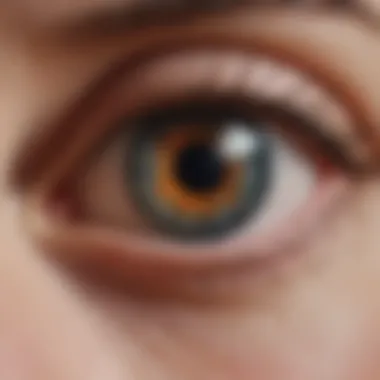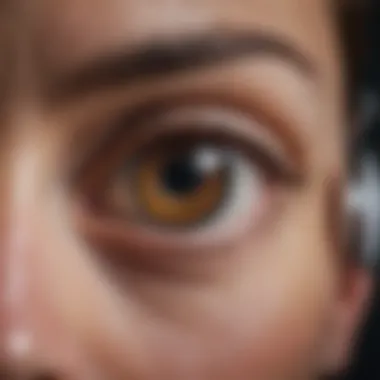Diabetes and Retinal Neovascularization: Key Insights


Intro
Neovascularization in the retina serves as a significant health concern for individuals diagnosed with diabetes. This process involves the abnormal formation of new blood vessels, which can lead to severe vision loss if not properly managed. Understanding the interplay between diabetes and retinal neovascularization is crucial in addressing the complications that arise from these conditions.
Diabetes, particularly when long-standing and poorly controlled, can trigger various pathological changes in the body. One major effect is on the eyes, where the retina is highly vulnerable due to its intricate vasculature. When blood sugar levels are persistently high, a cascade of biochemical reactions may ensue, leading to the characteristic symptoms of diabetic retinopathy, including neovascularization.
There is much to explore regarding how hyperglycemia (high blood sugar) facilitates neovascularization and its broader implications on retinal health. This complexity not only underscores the necessity for early detection and intervention but also highlights the importance of ongoing research into effective treatment strategies.
Intro to Neovascularization
Neovascularization refers to the process of new blood vessel formation, often occurring in response to various pathological conditions, including diabetes. This phenomenon is critical in understanding how retinal health deteriorates due to diabetes-related complications. Neovascularization in the retina can lead to severe visual impairment and is one of the hallmark signs of diabetic retinopathy.
The importance of studying neovascularization lies in its implications for patient care and treatment strategies. As diabetes continues to rise globally, understanding the mechanisms behind retinal neovascularization becomes paramount in devising effective interventions. This section serves to establish a foundational knowledge of neovascularization, setting the stage for deeper exploration into its specific effects on the retina and the overall health of individuals with diabetes.
Definition of Neovascularization
Neovascularization is the formation of new blood vessels from existing vessels. This process can be physiological in cases such as healing or it can become pathological, as seen in conditions like diabetic retinopathy. In the retina, neovascularization occurs in response to ischemia or low oxygen levels, frequently associated with uncontrolled diabetes.
Pathologically, the newly formed vessels tend to be fragile and can lead to complications such as hemorrhage or scarring. Understanding this definition is crucial, as it shapes the clinical approach to managing diabetic retinopathy and related retinal disorders.
Historical Perspective
The study of neovascularization has evolved considerably over the decades. Initial observations of retinal changes in diabetic patients can be traced back to the early twentieth century. However, breakthroughs in technology and a better understanding of the disease processes have fundamentally changed how researchers and clinicians approach the topic.
Significant advancements were made in imaging techniques, which allowed for detailed visualization of retinal structures, including blood vessels. Key studies in the latter part of the twentieth century identified the role of vascular endothelial growth factor (VEGF) in the development of neovascularization. This opened new avenues for therapeutic strategies, such as anti-VEGF treatments, which have transformed the management of complications associated with diabetes.
Overall, the historical evolution of neovascularization research highlights its relevance and ongoing significance in managing diabetic eye diseases. This understanding equips healthcare professionals to better anticipate and mitigate the complications that arise from neovascularization.
Diabetes and Its Effects on the Eye
Understanding diabetes and its effects on the eye is crucial for both prevention and management strategies related to diabetic retinopathy and retinal neovascularization. Diabetic conditions can severely impair vision through direct and indirect mechanisms. The retina is particularly vulnerable to microvascular complications, leading to various ocular issues. With the increasing prevalence of diabetes globally, awareness and knowledge about these effects are paramount.
One significant consequence of diabetes is the development of diabetic retinopathy. This condition can progress without noticeable symptoms until it becomes advanced. Thus, regular screening and monitoring are important for early intervention. Additionally, diabetes influences the eye's vascular system, resulting in altered blood flow and potential neovascularization.
Types of Diabetes
Diabetes primarily manifests in two forms: Type 1 and Type 2, each with distinct characteristics.
Type 1 Diabetes results from an autoimmune reaction that destroys insulin-producing beta cells in the pancreas. Patients typically present with a sudden onset of symptoms, often in childhood or early adulthood. Without adequate insulin, glucose levels rise, leading to various complications, including those affecting the retina.
Type 2 Diabetes is more prevalent and usually develops in adults. It stems from insulin resistance coupled with a relative deficiency of insulin. This type may not have immediate severe symptoms, often being diagnosed at a later stage. Over time, high blood sugar can cause systemic damage, particularly to the retinal blood vessels, contributing to neovascularization.
Pathophysiology of Diabetes
The pathophysiology of diabetes involves complex metabolic changes that contribute to its systemic impact, including on the eyes. Insulin resistance and insufficient insulin secretion lead to chronic hyperglycemia.
Elevated glucose levels affect various cellular processes. In the retina, hyperglycemia triggers oxidative stress and promotes inflammatory pathways. These changes can result in damage to endothelial cells lining blood vessels in the retina, leading to microaneurysms and leakage of fluid and blood.
Another critical aspect is the role of advanced glycation end products (AGEs), which are formed when glucose binds to proteins. AGEs contribute to inflammation and vascular damage, further accelerating retinal changes associated with diabetes.
In summarizing diabetes's effects on the eye, the overarching theme is the interplay between metabolic dysregulation and retinal vulnerability. Understanding these mechanisms is essential for developing effective diagnostic and therapeutic strategies in managing conditions like diabetic retinopathy and its associated neovascularization.
Mechanisms of Retinal Neovascularization in Diabetes


The mechanisms that drive retinal neovascularization in diabetes are vital for understanding the progression of diabetic retinopathy. This condition causes significant vision impairment and can lead to irreversible loss of sight. Thus, grasping these mechanisms can help healthcare providers develop targeted interventions to manage and potentially reverse the effects of this pathology.
Role of Hyperglycemia
Hyperglycemia is a defining aspect of diabetes. Elevated glucose levels can result in various biochemical changes within the retina. One primary effect is the damage to the retinal blood vessels. When blood glucose levels remain high, it causes oxidative stress, activating pathways that promote inflammation and vascular leakage. This state can lead to the development of intraretinal microvascular abnormalities.
Long-term hyperglycemia leads to the accumulation of advanced glycation end-products (AGEs). These compounds can disrupt normal cellular functions, promoting further neovascularization. Understanding how hyperglycemia leads to neovascular changes is crucial, as controlling blood glucose levels may reduce the risk of progression to severe retinal complications.
Inflammatory Responses
Diabetes triggers a chronic inflammatory state that has a crucial role in retinal neovascularization. Elevated levels of pro-inflammatory cytokines are observed in individuals with diabetes. These cytokines can disturb the balance of angiogenic factors, leading to excessive new blood vessel formation in the retina. This process, known as angiogenesis, is primarily where new blood vessels form from pre-existing ones.
One critical change is an increase in Vascular Endothelial Growth Factor (VEGF). It no longer remains confined under normal conditions but elevates in states of inflammation. VEGF promotes vascular permeability, leading to exudates and edema in the retina, worsening diabetic retinopathy. Thus, targeting these inflammatory responses may potentially offer therapeutic options for managing neovascularization.
Hypoxia in the Retina
Hypoxic conditions arise when there is inadequate oxygen supply to the retina, a common issue in diabetes. High levels of glucose lead to vascular damage, resulting in reduced blood flow to the retinal tissues, further exacerbating the oxygen deficiency. In response to hypoxia, the retina increases the production of angiogenic factors, including VEGF, to stimulate the formation of new blood vessels in an effort to restore oxygen supply.
However, this neovascularization is often disorganized and leaky, resulting in further visual impairment. The understanding of hypoxia as a trigger for retinal neovascularization highlights the importance of oxygen levels in diabetic patients.
"Maintaining optimal blood glucose control can help mitigate the hypoxic conditions that fuel retinal neovascularization, potentially preserving vision."
By examining the interplay between hyperglycemia, inflammatory responses, and hypoxia, researchers and clinicians can better understand the complexities of retinal neovascularization in diabetes. Each mechanism highlights a path that contributes to the disease, reinforcing the need for comprehensive management strategies targeted at both glycemic control and inflammatory processes.
Clinical Manifestations of Diabetic Retinopathy
Diabetic retinopathy is a serious complication of diabetes, leading to significant impairment of vision and blindness if not managed effectively. Recognizing the clinical manifestations of this condition is crucial for timely diagnosis and intervention. Understanding these manifestations not only contributes to better patient outcomes but also emphasizes the importance of regular eye examinations for individuals with diabetes. The symptoms can be subtle at first, and many sufferers may not realize the extent of their condition until it's advanced. Thus, awareness of the clinical signs and stages is vital.
Stages of Diabetic Retinopathy
Diabetic retinopathy can be categorized into distinct stages, which allows for targeted management strategies. The stages are:
- Mild Non-Proliferative Retinopathy: At this stage, microaneurysms appear, small swellings in the blood vessels of the retina. This is often asymptomatic but is the first indication of disease.
- Moderate Non-Proliferative Retinopathy: Here, more prominent blood vessel changes occur. The risk of progressing to a more severe state increases. Symptoms may start to emerge, although they remain often unnoticed.
- Severe Non-Proliferative Retinopathy: This stage shows a significant drop in blood flow due to blocked vessels, leading to an increased risk of developing proliferative retinopathy.
- Proliferative Diabetic Retinopathy: This final stage is marked by the growth of new, abnormal blood vessels on the retina and, sometimes, the vitreous. These vessels are fragile, increasing the risk of bleeding and severe vision loss.
Symptoms and Signs
The symptoms of diabetic retinopathy can vary significantly depending on the stage of the disease. Early stages may present no symptoms, while more advanced stages can manifest with several signs:
- Blurred Vision: Changes in retinal blood vessels can lead to difficulty in focusing.
- Floaters: These are small spots or lines that float across one’s field of vision, often indicating bleeding in the eye.
- Dark or Empty Areas in Vision: This may occur due to significant damage to the retina, impacting the transmission of visual signals.
- Colors Appear Dull: A loss of vivid colors can indicate retinal damage.
"Early detection of diabetic retinopathy can prevent vision loss, making eye examinations crucial for individuals with diabetes."
Importance of Awareness: Recognizing these manifestations is essential for both patients and healthcare providers. Regular screening and monitoring can ensure prompt intervention and treatment, preserving vision and enhancing quality of life. Identifying symptoms early can lead to more effective management, which is particularly beneficial in slowing disease progression.
Diagnosis of Retinal Neovascularization
Diagnosis of retinal neovascularization is a crucial aspect in understanding and managing diabetes-related implications. Early and accurate diagnosis can significantly influence the treatment outcomes and progression of diabetic retinopathy. Identifying neovascularization ensures that patients receive timely interventions, reducing the risk of severe vision loss. Considering the complex nature of retinal changes in diabetic patients, a multi-faceted diagnostic approach is key.
The importance of this topic lies not only in its medical implications but also in its socio-economic impact. Vision loss due to diabetic retinopathy can severely affect an individual's quality of life and independence, leading to a burden on healthcare systems. Thus, enhancing the diagnostic capabilities and understanding the underlying mechanisms can ultimately improve patient care.
Fundus Examination Techniques
Fundus examination is a fundamental technique used for diagnosing retinal neovascularization. It allows for direct visualization of the retina's condition. One essential method is direct ophthalmoscopy, which gives clinicians an initial view of the retina.


Another effective technique is indirect ophthalmoscopy. This method expands the field of view, allowing clinicians to detect more extensive changes. In some cases, practitioners might use a slit-lamp bio-microscopy to examine the retina in detail. This technique helps in identifying smaller lesions that may indicate the onset of neovascularization.
Advanced Imaging Modalities
While basic fundus examination techniques are critical, advanced imaging modalities provide more detailed insights into retinal health. Optical coherence tomography (OCT) is a cutting-edge imaging technique that produces cross-sectional images of the retina. This allows for quantification of retinal thickness and identification of fluid accumulation, which are pivotal in assessing neovascularization.
Moreover, fluorescein angiography is another indispensable tool. It involves injecting a fluorescent dye into a vein, which then illuminates the blood vessels in the eye. This technique helps detect abnormal vessel growth, providing valuable information about the severity and extent of neovascular changes.
Biomarkers for Diagnosis
Identifying specific biomarkers can enhance the diagnostic process for retinal neovascularization. Biomarkers allow for a non-invasive assessment of disease progression. Recent studies have shown that levels of certain proteins in serum can be associated with increased risk of developing neovascularization.
Examples of these biomarkers include vascular endothelial growth factor (VEGF), which plays a significant role in the formation of new blood vessels. Elevated levels of VEGF have been linked to increased neovascularization in the retina. Additionally, other inflammatory markers may also offer insights into individual risk profiles, contributing to a more precise approach in managing diabetic retinopathy.
Early diagnosis and appropriate management of retinal neovascularization can have profound effects on the prognosis and quality of life for diabetic patients.
By employing a combination of fundus examination, advanced imaging techniques, and biomarker assessment, practitioners can build a comprehensive approach to diagnosing retinal neovascularization, which is vital for effective patient management.
Management Strategies for Retinal Neovascularization
The management of retinal neovascularization, especially in the context of diabetes, is critical for maintaining visual acuity and overall eye health. Effective strategies are necessary to counteract the potential complications that arise from this condition. Understanding these strategies helps patients and healthcare providers make informed decisions regarding treatment options. In this section, we will explore current treatment methods and surgical interventions that address neovascularization in the retina.
Current Treatment Options
Current treatment options for retinal neovascularization primarily focus on controlling the progression of diabetic retinopathy and minimizing vision loss.
- Anti-VEGF Therapy: One of the most common approaches involves the use of anti-vascular endothelial growth factor (anti-VEGF) injections. These medications inhibit the action of VEGF, a protein that stimulates blood vessel growth. By reducing VEGF levels, these injections help to decrease neovascularization and associated edema. Examples include Aflibercept and Ranibizumab.
- Laser Photocoagulation: This is a traditional but still effective treatment. Laser therapy targets specific retinal areas to seal leaking blood vessels or destroy abnormal cells. It can slow down the progression of the disease. There are two main types: scattered laser therapy and focal laser therapy.
- Corticosteroids: These drugs are used to reduce inflammation and macular edema. They can be administered intravitreally or through sustained-release implants. While effective, the long-term use of corticosteroids may have potential side effects, such as cataract formation.
- Combination Therapy: Combining anti-VEGF treatments with corticosteroids or laser therapy is increasingly common. This multidisciplinary approach can enhance treatment effectiveness, addressing both neovascularization and its complications.
Effective management of retinal neovascularization helps preserve vision and improve quality of life for patients with diabetes.
Surgical Interventions
When non-invasive treatment options do not yield satisfactory results, surgical interventions may be necessary.
- Vitrectomy: This procedure involves the removal of the vitreous gel from the eye. Vitrectomy is recommended when there is significant hemorrhage or tractional retinal detachment related to diabetic retinopathy. This surgery can improve visibility and facilitate further treatment.
- Membrane Peeling: This surgical technique targets epiretinal membranes that contribute to traction on the retina, causing visual impairment. Removing these membranes can restore better retinal structure and function.
- Retinal Reattachment Surgery: In cases of severe retinal detachment, surgical repair may be required. Techniques include scleral buckling or pneumatic retinopexy to realign the retina and restore normal positioning.
Future Directions in Research
Research into neovascularization in the retina, particularly in relation to diabetes, continues to evolve. This area of study is vital as it holds implications not only for understanding the disease but also for developing effective treatment strategies. As diabetic retinopathy remains a leading cause of blindness, innovation and exploration of new methodologies are essential for improving patient outcomes and preventative measures.
Emerging Therapies
Emerging therapies provide potential hope for individuals suffering from diabetic retinopathy. The advancement of pharmacologic treatments is being investigated rigorously. One such class of medications includes anti-VEGF (Vascular Endothelial Growth Factor) agents. These drugs inhibit the growth of new blood vessels in the retina, thereby preventing vision loss. Other promising avenues include:
- Tyrosine Kinase Inhibitors: These aim to block signaling pathways that promote angiogenesis (formation of new blood vessels).
- Sustained Release Systems: Researchers are exploring innovative delivery systems that allow for steady medication release, reducing the need for frequent injections.
These therapies may not only halt progression but could potentially reverse damage. Future studies will focus on refining these therapies for greater efficacy and safety.
Gene Therapy Approaches
Gene therapy is another burgeoning field that presents new avenues for intervention. This technique aims to correct genetic defects at the molecular level, potentially offering long-term solutions for retinal diseases related to diabetes. Key approaches being investigated include:
- Gene Transfer: Introducing therapeutic genes into retinal cells to promote protective mechanisms against retinal damage.
- CRISPR Technology: This allows for precise editing of genes to correct mutations associated with various forms of retinopathy.


The implications of successful gene therapy are profound. If these methods can be safely deployed, they could lead to definitive cures rather than symptom management, which is the current standard.
Preventive Strategies
Preventative strategies are crucial in addressing diabetic retinopathy before it escalates. These strategies not only aim to reduce the incidence of retinal neovascularization but also enhance overall patient health. Effective measures include:
- Regular Screening: Early detection through routine eye examinations can lead to timely treatment, reducing the risk of severe progression.
- Patient Education: Teaching patients about the importance of diabetes control, including maintaining blood glucose levels and understanding their condition, can empower individuals.
- Lifestyle Changes: Encouraging changes such as diet modifications and increased physical activity significantly impact overall health, which in turn affects the progression of diabetic retinopathy.
Research shows that effective lifestyle changes can reduce diabetes complications.
In summary, the future of research in diabetic neovascularization is promising. By focusing on emerging therapies, innovative gene therapy approaches, and preventive strategies, researchers can hope to make significant advancements. This multifaceted approach is critical to advancing treatment options and improving quality of life for those affected by diabetes-related eye conditions.
Impact of Lifestyle and Management on Outcome
The relationship between lifestyle choices and the management of diabetes-related retinal neovascularization cannot be overstated. This aspect is crucial as it directly influences both the progression of retinopathy and patient outcomes. The factors that play a significant role include glycemic control, dietary considerations, and physical activity. Each of these elements not only affects the individual’s overall health but also specifically impacts the vascular health of the retina. Understanding the implications of these areas offers both patients and healthcare providers valuable insights for effective management strategies.
Importance of Glycemic Control
Glycemic control is central to managing diabetes and preventing complications associated with retinal neovascularization. Elevated blood glucose levels can lead to damage in various tissues, particularly in the retinal microenvironment. Consistent monitoring of blood sugar levels, aiming for optimal ranges, serves as a foundational strategy.
Research indicates that maintaining a hemoglobin A1c level below seven percent can significantly reduce the risk of developing diabetic retinopathy. Patients are encouraged to work closely with their healthcare teams to establish personalized targets.
Additionally, the implementation of tools like continuous glucose monitors can aid in real-time tracking, promoting healthier glycemic patterns.
Dietary Considerations
Nutrition plays an essential role in the overall management of diabetes. Specific dietary choices can affect blood sugar levels and, consequently, the risk of retinal complications. A diet high in whole grains, lean proteins, and plenty of fruits and vegetables can promote better glycemic control.
Key dietary considerations include:
- Carbohydrate Management: Paying attention to carbohydrate intake helps in regulating blood sugar levels effectively.
- Healthy Fats: Incorporating sources of omega-3 fatty acids, found in fish such as salmon or supplements, may contribute to retinal health.
- Antioxidant-Rich Foods: Foods high in antioxidants can help mitigate oxidative stress in the retina, which is exacerbated by diabetes.
Maintaining proper hydration also supports metabolic health, making water the beverage of choice over sugary drinks.
Exercise and Its Benefits
Physical activity is another critical component in the management of diabetes and its ocular complications. Regular exercise has multifactorial benefits that extend beyond weight management. It enhances insulin sensitivity, leading to better blood glucose control.
Engaging in aerobic exercises, such as walking, cycling, or swimming, at least three to five times a week can yield significant health gains. The recommended duration varies, but accumulating 150 minutes of moderate-intensity exercise weekly is advisable.
Benefits of exercise include:
- Improved Cardiovascular Health: This is essential considering the link between cardiovascular disease and diabetic complications.
- Weight Management: Helps in maintaining a healthy body weight, reducing overall diabetes risk.
- Stress Reduction: Physical activity can lower stress levels, further supporting blood sugar regulation.
Regular physical activity not only strengthens the body but also fortifies ocular health through improved blood flow and reduced risk factors for retinal damage.
Epilogue
The conclusion of this article serves as a pivotal encapsulation of the essential elements discussed regarding neovascularization in the context of diabetes. Understanding the intricacies of retinal neovascularization is crucial due to its implications for patient care and management strategies for individuals with diabetes.
This area of study emphasizes the need for heightened awareness among healthcare professionals and patients alike, fostering early detection and intervention. The consequences of unchecked neovascularization can lead to severe vision impairment or even blindness, underlining the importance of a proactive approach.
Key considerations highlighted include:
- The mechanisms linking diabetes and neovascularization: Hyperglycemia, inflammation, and hypoxia are principal drivers that initiate abnormal blood vessel growth in the retina.
- Current diagnostic measures: Advances in imaging technologies and examinations enable timely and accurate identification of retinal changes.
- Management strategies: A multifaceted approach combining medical therapies and lifestyle modifications can significantly alter disease progression and improve outcomes.
Overall, addressing these components not only enhances patient quality of life but also contributes to a broader understanding of diabetic complications, ultimately improving public health outcomes.
"Awareness and knowledge about diabetic retinopathy can transform clinical practices and patient lives."
The discussion sets the stage for future research initiatives aimed at unraveling the complexities of diabetic retinopathy and refining treatment modalities. Through collaborative efforts, the ultimate goal remains to preserve vision and enhance life quality for those affected.







